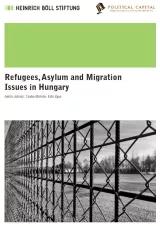Refugees, Asylum and Migration Issues in Hungary
When Viktor Orbán visited Warsaw in September 2017, he made the following statement at a joint press conference with his incumbent Polish counterpart, Beata Szydło: “We accept the decision of immigrant countries to become immigrant countries. We ask them to accept that we do not want to become one.” His statement succinctly summarises the Hungarian government’s main message to migrants, which is: “Do not come here.”
The irony is that Hungary, while bridling at the prospect of admitting migrants, is facing severe demographic challenges: an aging population, mass emigration, and a low birth rate. That Hungary should be a target for mass immigration is not one of its problems; to the contrary, Hungary’s greatest challenge is that almost no one wants to go there and its citizens, in increasing numbers, do not wish to stay either.
The rhetoric in Hungary towards refugees has not changed much since we published the first edition of this study in 2015, but the so-called “refugee crisis” is no longer present in the same way. What we observe in Hungary today is a rise in irrational fear and xenophobia. The hatred of refugees is exacerbated by populist politicians seeking electoral advantage.
Conspiracy theories have been at the top of the political agenda in Hungary in recent years. In 2017, the government launched a smear campaign against George Soros, alleging that he is “importing migrants from the Middle East with the help of Brussels in order to change the cultural background Europe”. The “Soros Plan” is a phrase used constantly by Fidesz politicians and media close to the government in order to fuel citizens’ fears and to “prove” that the Hungarian government has to protect the country against external threats and enemies.
This study aims to provide the reader with important background information, facts and data on the last three years of the “refugee crisis”, as well as its social, political, policy and diplomatic repercussions. The authors of the study not only analyse the Orbán government’s rhetoric and policy measures with regard to refugee, asylum and migration issues, they describe the historical context, supply valuable data, and explore the ways in which the government has influenced the public discourse.
Additionally, the authors highlight the regional context, raising the question of how far Budapest’s influence extends, and how the “refugee crisis” has affected regional cooperation.
- You can find more articles on Hungary in our online special
Product details
Table of contents
- Facts and trends
- Migration trends
The refugee crisis
Hungary’s unique position - The effect of the refugee crisis on political attitudes and preferences related to migration
Public perception
Xenophobia
Policymaking
Party politics
- Migration trends
- Politics and policies
- Orbán’s political strategy
- Asylum policy: securitisation
- Asylum policy in international context
- The importance of the asylum issue in terms of the political system
- Regional Outlook
- Anti-immigrant attitudes: regional trends
- How the refugee crisis has affected Visegrád cooperation
Slovakia
Czech Republic
Poland - How the infringement procedure will boost the Hungarian V4 presidency
- Budget negotiation: reluctant countries might be in trouble
- Diverging visions about the future of Europe
